AFGHANISTAN
Rising to the Challenge
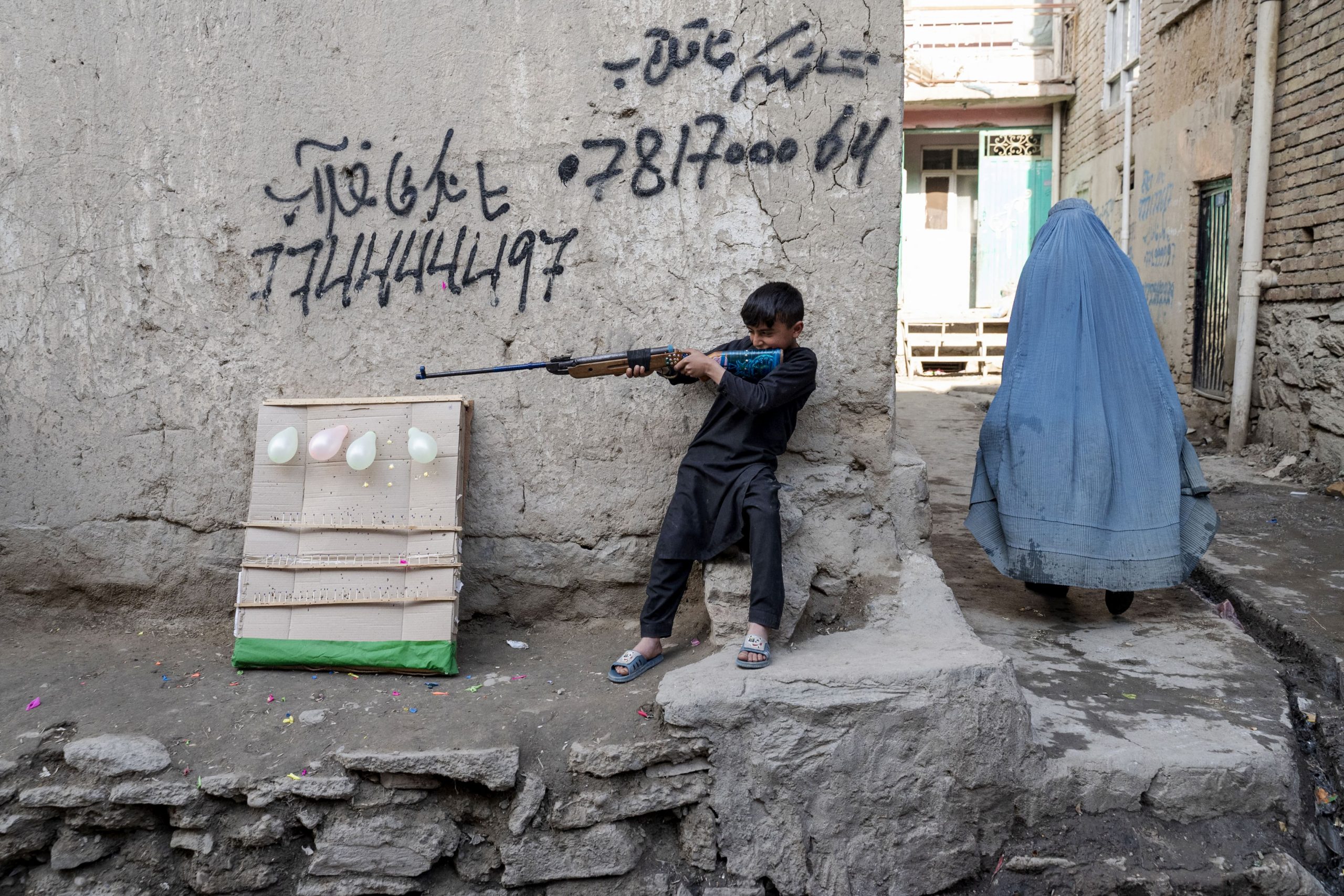
An Afghan burqa-clad woman walks past a boy carrying an airgun in Kabul on March 24, 2024. Since the Taliban’s ascension to power in August 2021, press freedom, gender equality, and human rights have been systematically dismantled, with many struggling to afford necessities. Credit: Wakil Kohsar / AFP
The country witnessed a worsening in press freedom and media rights over the past year, a backslide that began after the Taliban’s violent seizure of power on August 15, 2021. The achievements that Afghanistan had made in media development were swiftly eroded, plunging the years that followed into one of the darkest periods for press freedom in the country’s history.
Soon after taking over government, the Taliban imposed a series of restrictions on media outlets, severely curtailing their ability to operate independently. The media landscape in Afghanistan has been marred by a noticeable decline in both the quality and quantity of journalistic work. The economic viability of media organisations has been impacted, leading to layoffs, closures, and a reduction in the diversity of media voices.
Additionally, the right to access information has been curtailed, with the government controlling and censoring the flow of information. This has resulted in a lack of transparency and accountability, hindering the public’s ability to access accurate and unbiased news. Freedom of expression has been stifled, as journalists face intimidation, harassment and violence for daring to report on sensitive issues.
The restrictions imposed by the Taliban have had a particularly harsh impact on women journalists. They are denied the opportunity to participate in press conferences and are subjected to discrimination within the media industry. The Taliban’s oppressive policies have effectively silenced women’s voices and all but erased their contributions to journalism.
In addition to curbing of the media, journalists in Afghanistan face grave dangers to their personal safety. They are subjected to arbitrary arrests, detention, and even torture, simply for carrying out their professional duties. This climate of fear and intimidation has forced many journalists to self-censor, stifling their ability to report on critical issues and undermining the public’s right to information. A large number of journalists has been forced to flee Afghanistan since the Taliban takeover, thus reducing the number of professional journalists left in the country.
The current state of press freedom in Afghanistan is deeply concerning, as media organisations continue to face restrictions imposed by the Taliban-led government.
Right to access information
Before the Taliban’s return to power, Afghanistan had a relatively high level of access to information. The country had enacted its first Access to Information Law in 2014, which was later revised in 2018. In 2019, Afghanistan ranked first among 130 countries in terms of access to information as per the global RTI Rating. However, the situation drastically changed under the Taliban.
Access to government information has been curtailed, and the rights guaranteed by the Access to Information Law have been nullified. Journalists and the media community in Afghanistan now face significant challenges in obtaining information from the government. The authorities selectively release information that portrays the Taliban government in a positive light, while suppressing information that may be unfavourable. Omid (the names of all journalists mentioned in this report are pseudonyms), a journalist working in the western region, said, “Information regarding security matters is never shared with journalists.”
Although many government agencies have appointed spokespersons, journalists often face challenges in accessing timely information. While they can reach out to these spokespersons to request the necessary information, due to delays, news topics lose their relevance or are sometimes deliberately suppressed. There may also be instances where spokespersons themselves are not fully informed or authorised to share certain details.
Additionally, government officials sometimes withhold information, hindering journalists’ ability to report on important developments in a timely way.
Furthermore, female journalists face additional obstacles in accessing information in the context of the restrictions imposed by the Taliban on women and girls, in an effort to exclude them from the public sphere. Their requests for interviews and information are rejected by the authorities, and they are often excluded from press conferences and other media events. Masoumeh an active journalist, said, “When I went to government institutions to gather information, they would tell me to leave and send a male journalist to get the information.” Maryam, another journalist based in the capital added, “I was not given permission to gather information at the Kabul Museum because I did not have a male guardian accompanying me.” This gender-based discrimination limits women journalists’ ability to report on important issues and contribute to public discourse.
Although there may have been some improvements in certain aspects of public relations departments compared to the previous year, these improvements have not effectively addressed the ongoing challenges faced by journalists in accessing information.
Media Rights Violations
Killings
Arrests
“I was not given permission to gather information at the Kabul Museum because I did not have a male guardian accompanying me (mahram).”
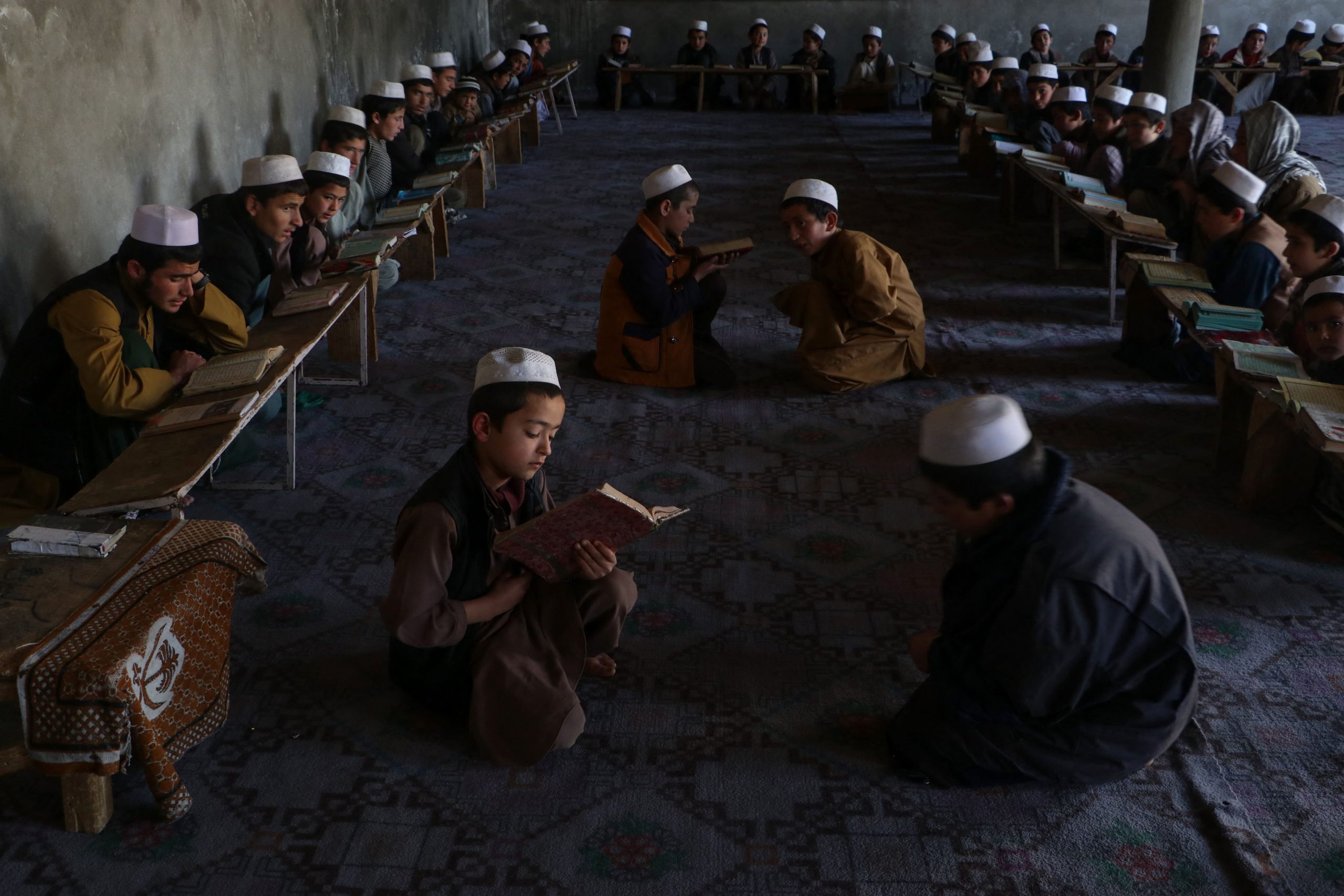
Afghan children read the holy Quran at a madrassa or Islamic school during the Islamic holy month of Ramadan in the Argo district of Badakhshan province on March 27, 2024. Despite nominal improvements since 2021, access to information in Afghanistan is severely challenged. Credit: Omer Abrar / AFP
Constitutional freedoms
Despite the ups and downs during the republic era (2001-2021), citizens, journalists, and media outlets were able to express their opinions on various issues without fear of government interference, harassment, or intimidation. However, with the rise of the Taliban in Afghanistan, the right to freedom of expression, enshrined in Article 34 of Afghanistan’s Constitution adopted in 2003, access to information, journalistic work, and independent media activities have lost their significance.
The Taliban do not recognise international conventions or domestic laws, including the right to freedom of expression. Conversations with working journalists reveal that the right to freedom of expression in Afghanistan has been completely eroded. Journalists claim that no reporter can freely pursue news reportage or write critical reports against the Taliban, which does not tolerate any form of criticism.
Economic blow
The media landscape in Afghanistan has undergone a profound transformation with the resurgence of the Taliban, resulting in severe constraints on press freedom. The Taliban’s control over media outlets has led to a range of restrictive measures, including the ban on film and music broadcasting, limitations on news coverage, and stifling of editorial independence. These restrictions have not only stripped media organisations of their freedom but have also dealt a significant economic blow to the industry.
One media owner from the western region describes his media organisation as being in its most dire economic state, to the extent that they are struggling to pay wages and meet other financial obligations. The lack of freedom to produce diverse programming that resonates with their audience and attracts advertisers for commercial partnerships further exacerbates their financial woes.
Another private media owner, Reza, echoes these concerns and emphasises that the lack of revenue poses the greatest threat. Without the necessary financial assistance from international donors, there is a real risk of their media organisation being forced to shut down. Additionally, due to the restrictions on accessing information, they have been compelled to suspend their news division, further limiting their ability to provide comprehensive coverage and also attract advertisements.
They highlight that the inability to produce diverse programs hinders their ability to attract commercial partnerships and generate income. As a result, they seek financial support from both domestic and international institutions that support media organisations in Afghanistan.
Economic constraints have also affected the employment of female staff, since limited resources and financial hardships impede their recruitment. Women journalists are unable to participate in press conferences and require a mahram (escort by male family member) when covering external reports. Cash strapped media owners prefer to hire male reporters to ensure coverage of all topics.
Media managers face the constant threat of interference from the Taliban’s intelligence agency. Any program or content that goes against their interests can present the risk of arrest and detention.
According to the findings of the Afghan Independent Journalists Union (AIJU) at present, there are currently 642 media outlets in Afghanistan, while 422 are active, 220 are inactive. Among these, there are 358 radio stations, 256 of them active and 102 inactive. There are 140 television stations, with 87 active and 53 inactive. The most important reason for the inactivity of the aforementioned media is economic, along with the imposed restrictions. In 2023, nine media started broadcasting again, most of them radio stations in the provinces.
Given the economic difficulties, a significant number of journalists are unemployed. Media organisations either lack the capacity to hire new employees or are unable to provide decent wages to journalists. Even those currently employed as journalists are struggling due to low wages.
Ahmad, a working journalist in the northern region, reveals that journalists currently receive a monthly salary ranging from 3,000 to 10,000 Afghanis (USD 40-140), which is insufficient to meet their basic needs. Malalai, a female journalist in the northern region, states that her wages are so meagre that even transportation costs cannot be covered. Fatima, a female journalist in the western region, says, “I was doing a lot of work for only 4,000 Afghanis (USD 55).” Ahmad, another journalist, explains that due to unemployment and economic hardships, he was forced to leave the country. However, after failing to find employment abroad, he had no choice but to return to Afghanistan.
According to the findings of the AIJU, prior to the rise of the Taliban, there were a total of 11,900 active journalists and media staff in the country. Out of this number, 2,833 were women, while 9,067 were men. However, the survey conducted by the union in March 2024 shows that there are approximately 4,764 journalists and media staff actively working, with around 700 women and 4,064 men. Approximately 5,003 male journalists and 2,133 female journalists have lost their jobs. The high unemployment rate among journalists spotlights the urgent need for support and intervention to improve their working conditions and ensure a sustainable media environment.
The lack of freedom to produce diverse programming that resonates with their audience and attracts advertisers for commercial partnerships further exacerbates their financial woes.
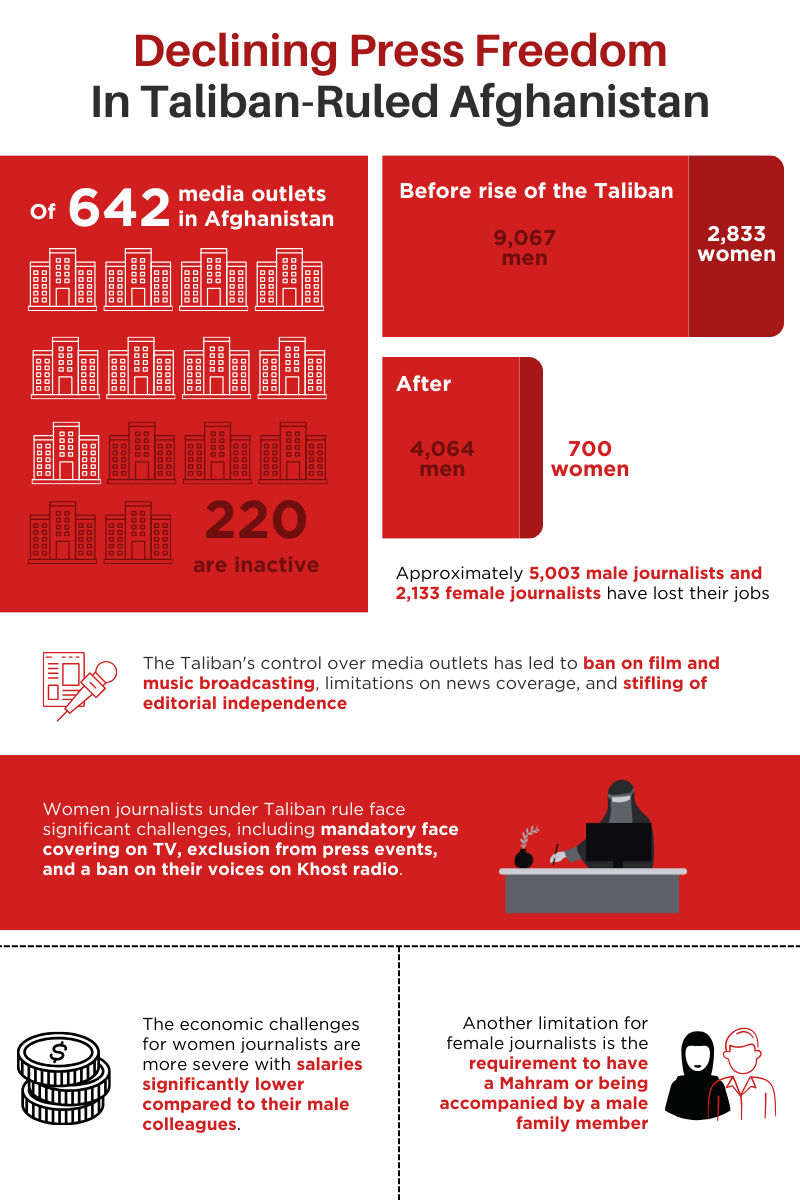
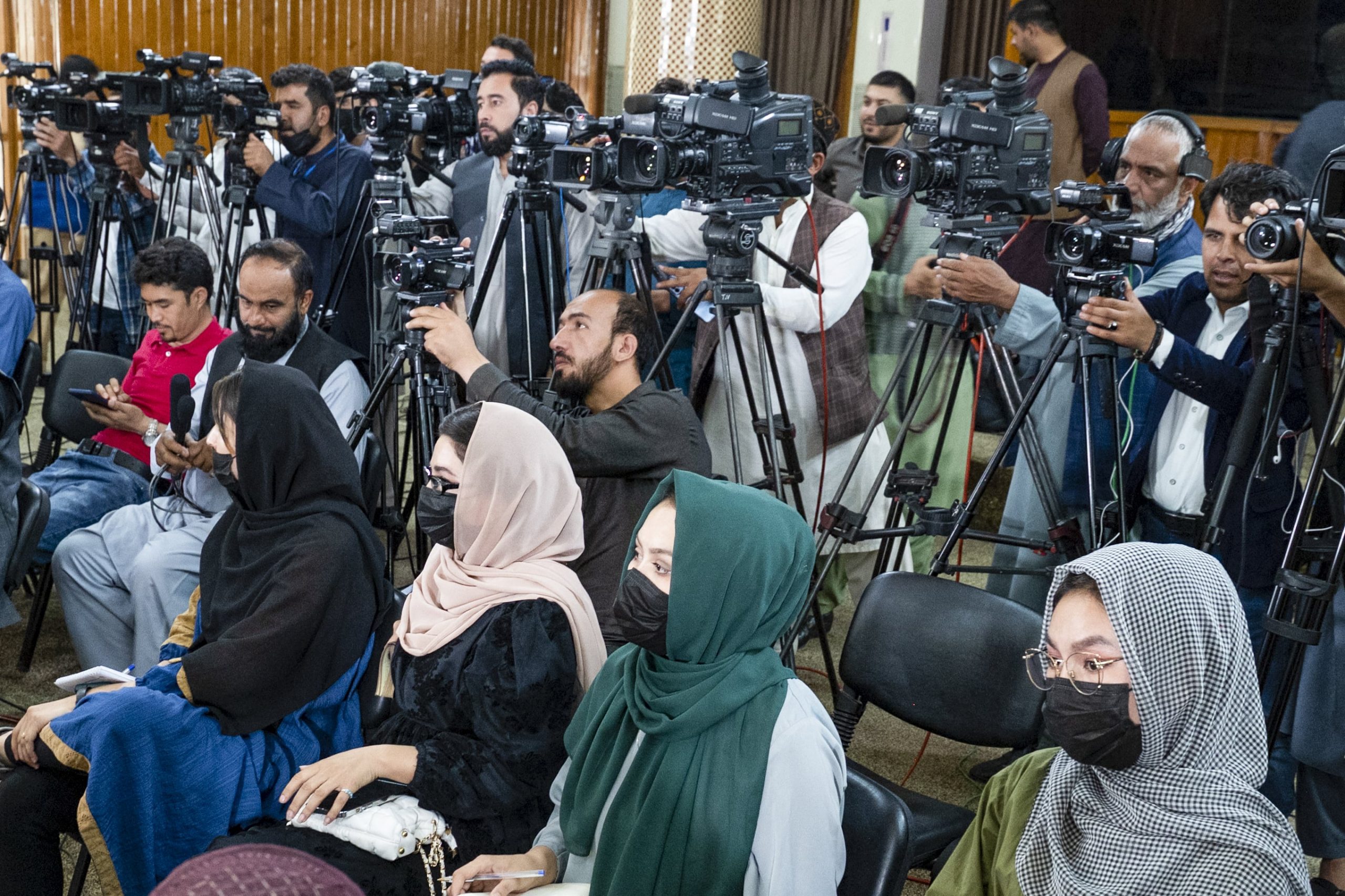
Afghan journalists attend a Taliban Ministry of Higher Education press conference in Kabul on August 21, 2023. Since August 2021, the Taliban has established strict barriers for journalists and media workers, with information funnelled through official channels, news restricted to official announcements, women barred from most press conference and media events. Credit: Wakil Kohsar / AFP
Female journalists
The situation for women journalists under Taliban rule is extremely challenging, as they face numerous restrictions. These restrictions include the requirement to cover their faces when appearing on television, the denial of participation in press conferences and programs, and the ban on broadcasting women’s voices on radios in Khost province. While journalists confirm the ban on broadcasting women’s voices, officials deny this claim. Women journalists face severe gender discrimination. The Afghanistan Journalists Support Organization announced on March 8, International Women’s Day, that the voices of women have been silenced in more than half of the country. There are reportedly no female journalists in the south and southeast of Afghanistan (Kandahar, Helmand, Zabul, Uruzgan, Paktia, Paktika, Khost and Logar), according to sources who wished to remain anonymous.
Shirin, a female journalist in the western region recounts her experience of being denied entry to a press conference, where a Taliban guard asked her why she was working, “A woman either belongs at home or in the cemetery”. Lala, an unemployed journalist, expresses her frustration at being unable to find employment due to the restrictions on women and the prevalent gender discrimination. As time goes by, she is uncertain about when or whether she will be able to work as a journalist again.
Elham, another unemployed journalist, states that gender discrimination is not limited to the Taliban but is also perpetuated by media managers. She shares her experience of being forced to wear a prayer veil (long scarf from face to feet, common in the western parts of the country particularly in Herat) during program broadcasts. Negar, a working journalist, complains about being discriminated as a woman while trying to access information, as women either do not receive information at all or face significant delays in obtaining it.
The economic challenges for women journalists are more severe than those faced by men. Arzu, a working journalist, reveals that her salary as a female journalist is significantly lower than that of her male colleagues. Sanam, an unemployed journalist in the northern zone, had to sell her camera and equipment due to poverty and economic difficulties, ultimately resorting to working as a seamstress.
There are reportedly no female journalists in the south and southeast of Afghanistan (Kandahar, Helmand, Zabul, Uruzgan, Paktia, Paktika, Khost and Logar).

Afghanistan’s Minister of Foreign Affairs, Amir Khan Muttaqi (C) speaks during a conference of special envoys from neighbouring nations on January 29, 2024. Many media operations in Afghanistan have faced financial difficulties following a withdrawal of significant foreign funding, with women journalists hit especially hard. Credit: Wakil Kohsar / AFP
Violence against journalists
During 2023-2024, Afghan journalists have been subjected to violence, including threats, humiliation, arrests, and torture.
Fahim, an active journalist, recounts a harrowing incident during his fieldwork. While conducting an interview with a young woman in a city, Taliban forces suddenly arrived and arrested Fahim and his cameraperson for the mere act of engaging in a conversation with a woman. They were detained for several hours and subjected to various forms of abuse and humiliation.
Farhad, another courageous journalist, shares his experience of covering a religious ceremony. During the event, he was targeted and physically assaulted by Taliban members, who aimed to suppress his reporting and intimidate him into silence.
According to the AIJU, there were 85 recorded cases of violence in 2023, including different forms of aggression. Some journalists were summoned to intelligence agencies and interrogated for hours – a process of intimidation which intelligence agencies refer to as normal working meetings with the media.
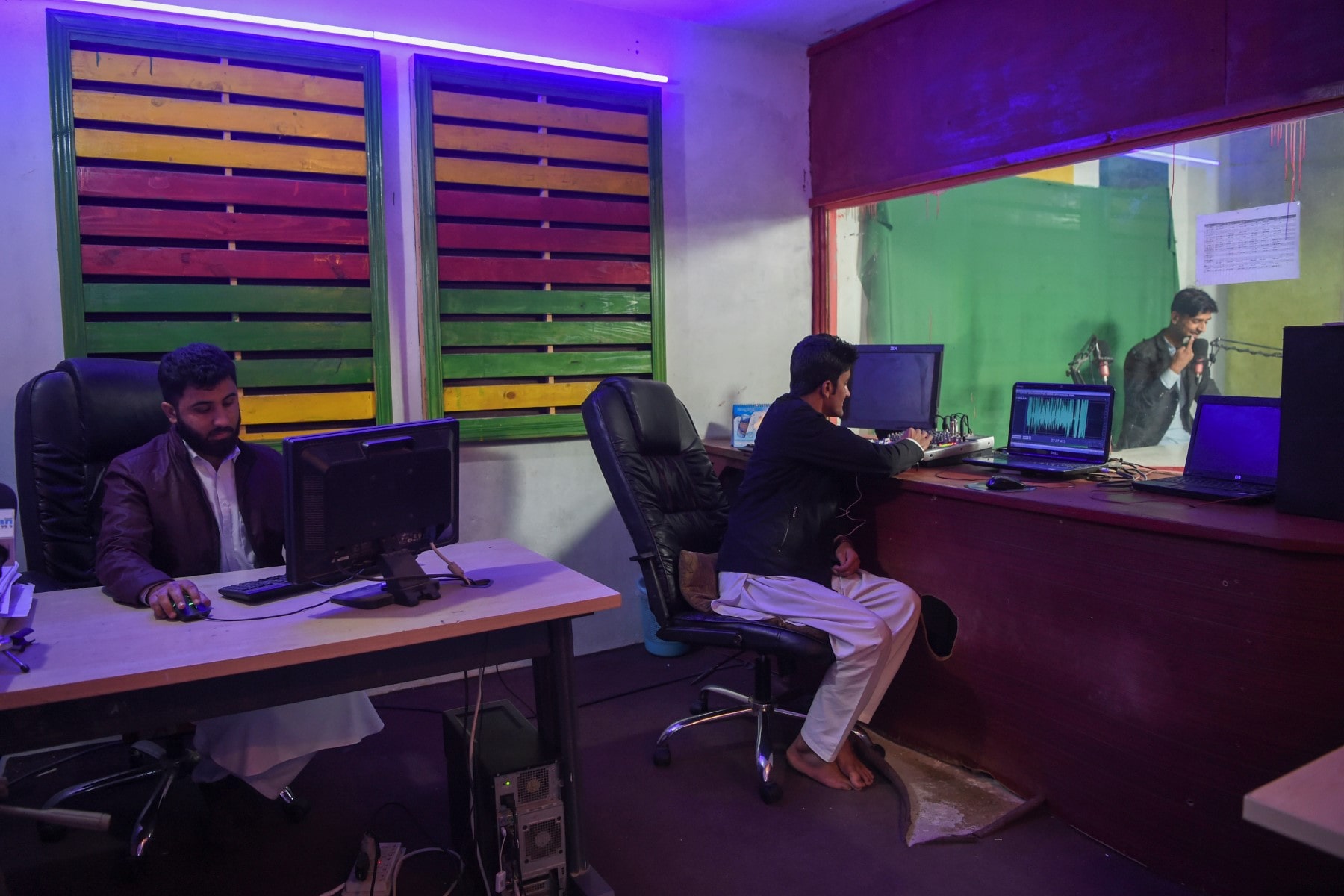
Radio Hamisha Bahar journalists and station employees work in a broadcast control room in December, 2021. Hamisha Bahar, shuttered for over a month through July and August 2023, are one of several news outlets and broadcasters shuttered for their violations of the Taliban’s draconian media code. Credit: Wakil Kohsar / AFP
Online Media
The landscape of online media in Afghanistan is complex and fraught with challenges. While some online platforms continue their activities with the approval and support of the Taliban government, those that operate contrary to the interests of the regime face censorship and filtering, or selectively restricting access to certain content or platforms, as well as the risk of revocation of their licenses. Prominent online news websites like Roznama-e-Hasht-e-Sobh and Etilaatroz have been filtered and had their licenses revoked due to their criticism of the Taliban.
YouTube, which operates within the framework of the Islamic government, enjoys relatively more freedom of expression. However, here too, there are limitations faced by content creators when interacting with government officials. They often experience demeaning treatment and encounter obstacles when trying to conduct interviews. YouTubers in Afghanistan are required to obtain licenses, making the process of running a channel particularly challenging.
Overall, the situation of platforms like YouTube can be considered relatively better than other forms of media. However, it is important to note that constraints still exist, affecting the freedom of expression and the ability of content creators to operate without hindrance.
Those that operate contrary to the interests of the regime face censorship and filtering, or selectively restricting access to certain content or platforms, as well as the risk of revocation of their licenses.
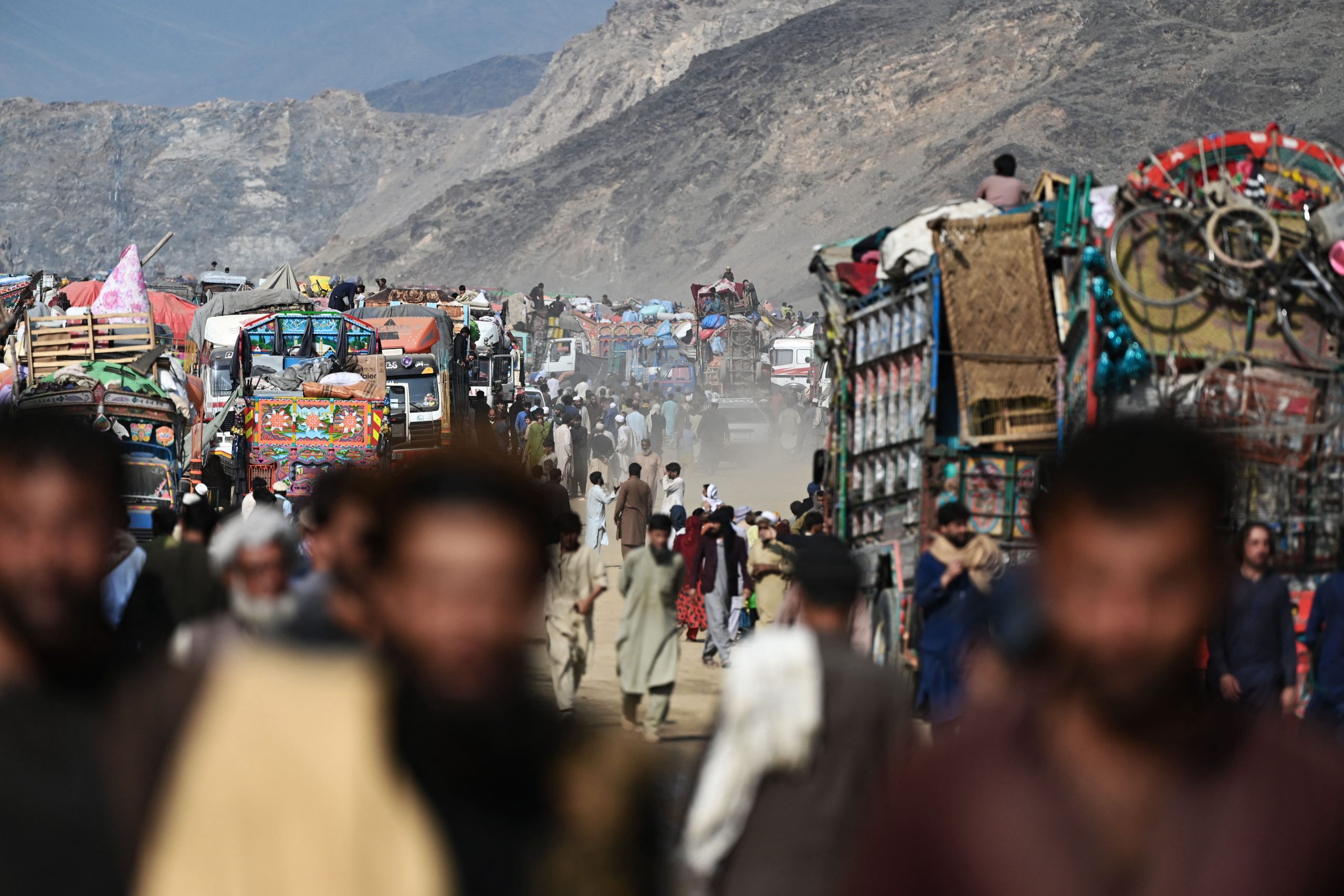
Afghan refugees gather at a makeshift camp upon their arrival from Pakistan, near the Afghanistan-Pakistan Torkham border in Nangarhar province on November 2, 2023. With many facing visa difficulties and insecure living situations, exiled Afghan media workers continue through new and existing outlets and collectives. Credit: Wakil Kohsar / AFP
Small steps forward
In 2023, several initiatives were undertaken to improve the situation of press freedom and the development of journalism in Afghanistan. Promoting dialogue and engagement has been one such step. Strengthening the Media Ethics Commission under the Ministry of Information and Culture to provide some form of accountability and establishing coordination committees between journalists and local officials in the provinces opens some possibilities for professional journalists to operate. Additionally, efforts were made to improve the economic conditions of the media compared to previous years, which is promising for the media community.
Initiatives were supported by AIJU and international organisations such as UNESCO included for instance, providing financial assistance to prevent the closure of eight radio stations, four of them managed by women, in Nangarhar, Jawzjan, Kunduz, Herat, Farah, Kandahar and Nuristan.
However, limited access to information, the summoning of media managers and the detention of journalists by intelligence agencies are concerning and challenge the authority of the commission responsible for investigating complaints and addressing media violations.
Media advocacy organisations and freedom of expression defenders are actively engaged in continuous and persistent efforts to defend and support freedom of expression and press freedom in Afghanistan.
In 2023, UNESCO’s office in Afghanistan had the highest number of collaborations with the media which included grants and funding of training programs for journalists throughout the country. These support initiatives played a vital role in sustaining and promoting freedom of expression, empowering Afghan journalists and media outlets to produce quality content. Media outlets were able to present social and political programs to some extent, despite the attempts by the Taliban to shape content. Alongside, media outlets in exile such as Amu TV, Zan Times, Etilaatroz and Kabul Now are making a brave effort to keep the spotlight on Afghanistan.
The challenges faced by the media industry in Afghanistan call for attention and support to uphold press freedom and independent journalism in the country. Overall, while progress has been made in some areas, the situation of press freedom in Afghanistan requires ongoing attention and action to ensure the rights and safety of journalists and to foster a climate conducive to a free and vibrant media landscape.
